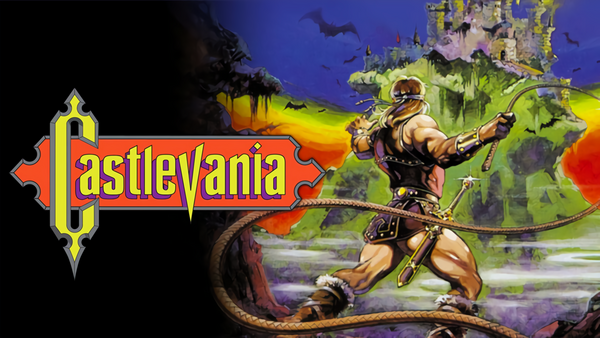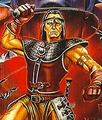The official discord link if you wish to join the discord: https://discord.gg/j5RKwCvAFu
Support the wiki on our official Ko-Fi page or Patreon page!
Castlevania: Difference between revisions
| Line 41: | Line 41: | ||
This should apply to all remakes and remasters of the series. Each one is considered to be the same scenario, and thus either one can be considered in place of one another, and not one is more canon than the other; “both should be legitimate.” | This should apply to all remakes and remasters of the series. Each one is considered to be the same scenario, and thus either one can be considered in place of one another, and not one is more canon than the other; “both should be legitimate.” | ||
===Order of Shadows=== | |||
This point will be using the [https://www.ign.com/articles/2007/08/23/castlevania-order-of-shadows-qa Order of Shadows Q&A conducted by IGN], as reference. | |||
Castlevania: Order of Shadows is a 2007 mobile game, developed and published by Konami, which has almost unanimously been grouped into the "Non-Canon" section by fans of the series. This is likely due to a very vague statement made by the director of the game, Tyrone Rodriguez, where he called the game a "gaiden," aka a side-story. This is not sufficient enough evidence to strip the story from the timeline, and there is in fact several more points to it being canon than not. | |||
* '''Debunking "It's a side story, thus isn't canon"''' | |||
This is basically the only evidence levied against the games canonicity, and simply isn't true. A side-story does not mean it is not canon, in fact its far from it. This simply means that the events of the game are not as major to the timeline as others, which reigns true. This game features a resurrection of Dracula that does not occur during one of his 100 year cycles (much like Harmony of Dissonance or Curse of Darkness,) and thus is considered a side-story. This has nothing to do with canonicity, and is taken out of context as well: | |||
''IGN Wireless: What sort of timeframe in relation to other Castlevania titles?'' | |||
''TR: Officially, Order of Chaos is considered a "gaiden" or side story to the Castlevania canon. However, it takes place roughly in the late 1600s.'' | |||
Here, Tyrone explicitly states that the story is a side-story to the canon, implying that it exists within the canon but funcions as a side-story. This is backed up when he gives the game a chronological timeframe as well. | |||
===Timeline=== | ===Timeline=== | ||
| Line 60: | Line 75: | ||
*'''Castlevania Judgement''' (Time Rift) | *'''Castlevania Judgement''' (Time Rift) | ||
==Non-Canon== | |||
These are games within the series that are specifically excluded from the official main-series timeline, whether because they take place in their own continuity, contradict the main continuity, or for unknown reasons. | These are games within the series that are specifically excluded from the official main-series timeline, whether because they take place in their own continuity, contradict the main continuity, or for unknown reasons. | ||
Revision as of 05:31, 17 July 2021

Background
The Castlevania games are a series of video games produced by Konami. This is one of the company’s most successful and long-running franchises, spanning several different consoles from Nintendo consoles to the Playstation. The first game, Castlevania, released in 1986 for the Nintendo Entertainment System.
The Castlevania games tell the tale of a familial clan of vampire hunters and their quest to rid the world of Count Dracula, with heavy ties to Bram Stoker’s Dracula. Each game chronicles a different member of the Belmont family and their quest to defeat the creatures of the night. The gameplay across the games is split into three different genres; Classic Castlevania, which functions as a side-scroller; Metroidvania, which provides a large singular map and focuses on exploration and back-tracking; and 3D Castlevania, which adapts the Metroidvania style into a 3D plane.
Each Castlevania game is set in the same universe, with only a few notable exceptions (Castlevania Legends, Kid Dracula, the Lords of Shadow series.) Nearly every game’s main character shares a familial connection.
The Belmont Clan takes center stage as the main characters, each being noted as legendary vampire hunters. Every member of the Belmont clan wields the powerful Vampire Killer whip, which was given to the Clan as the Whip of Alchemy, by an alchemist named Rinaldo Gandolfi.
The main recurring rival of the Belmont Clan is Lord Dracula, a powerful immortal vampire who has existed for several hundred years. Having a deep hatred for God and humanity, Dracula curses the land of which he stands, and returns every 100 years after he is killed. Castlevania: Lament of Innocence established that Count Dracula was once a regular human and masterful tactician named Mathias Cronqvist, who was also best friends with the ancestor of the Belmont Clan, Leon Belmont. After the death of Mathias’ wife, he swore vengeance against God and sought out a powerful relic known as the Crimson Stone to become the Dark Lord, Count Dracula.
As the Dark Lord, Dracula has domain over a great many things, including a large castle known fittingly as Castlevania. This castle is directly tied to Dracula’s power, will rise when Dracula himself is resurrected, and will crumble as Dracula is defeated. Both the powers of Castlevania and Count Dracula are sourced in primordial Chaos, and the parallel universe known as the Chaotic Realm, in opposition to God’s order and law. Because of his status as the Dark Lord, Dracula has control over a large number of different evil creatures; ranging from skeletons, zombies, mermen, werewolves, bats, gargoyles, ghosts, Medusa, Frankenstein’s Monster, and Death.
There are also several other Clans of vampire hunters in the series who assist in the destruction of Count Dracula. Such as the Morris Clan, which functions as the successor to the Belmonts and inherits their Vampire Killer whip, during the nearly two centuries that the Belmont Clan had disappeared. There are also the Belnades, Renard, Lecarde, and Kischine Clan, which have been seen assisting the Belmont Clan in some of their most important battles.
Terms
- Chaos: Chaos is the primordial entity, once formless matter that existed before the creation of the universe, which was formed as the opposition to God’s order and law. Chaos exists in a realm known as the Chaotic Realm, which is visibly a parallel universe to the main one in which the games take place. When Mathias Cronqvist rejected God and became the Dark Lord, his powers became rooted in the Chaotic Realm, so that he would continue to live on so long as Chaos existed, along with the hatred within the hearts of mankind. Chaos was also the entity that chose Soma Cruz to be the reincarnation of Count Dracula and made him the Dark Lord, after Dracula was killed once and for all in 1999. When Soma Cruz enters the Chaotic Realm, Chaos takes on a physical form for their battle. Chaos is responsible for many things that Dracula and Soma are capable of doing.
- Power of Dominance: An ability that is given to the Dark Lords chosen by Chaos; notably Count Dracula, and his reincarnation Soma Cruz. This is a special power that allows for the user to extract and absorb the souls of those they defeat; absorbing their souls then allows them to perfectly mimic the abilities of the monster whose soul was absorbed. This is an ability that Chaos can give and take away from those it considers the Dark Lord.
- Vampire Killer: The Vampire Killer whip was originally created as the Whip of Alchemy by an alchemist named Rinaldo Gandolfi. When his daughter was turned into a vampire by a demon lord known as Walter Bernhard, Rinaldo created the Whip of Alchemy as a way to confront Walter and get revenge. Unfortunately, the Whip of Alchemy was far too weak to defeat Walter in Rinaldo’s hands, and so he decided to give the whip to a young knight named Leon Belmont in hopes that he could bring the whip’s latent power out. Eventually, the Whip of Alchemy was infused with the vampiric soul of Leon’s betrothed, Sara Trantoul, and transformed into the powerful Vampire Killer whip; a whip that is specifically made for destroying the creatures of the night. It has gone through drastic design changes, from a simple leather whip, to chain whip with a flail and a cross-shaped handle; the former being considered the “canon” design, and being the one that was adapted into the Super Smash Bros. series. The Vampire Killer whip not only acts as a powerful weapon against demons, but can also act as a seal against them to keep their magic suppressed. Furthermore, it contains a realm within it that is accessed through the Lecarde Clan, that hosts the whip's memories and can summon apparitions of its previous wielders. If the Vampire Killer is wielded by someone it does not view as worthy of it, it will slowly drain the life force from them until they perish.
- Dominus: This is a powerful glyph created by Barlowe of the Order of Ecclesia, which is viewed as the ultimate weapon against Dracula’s evil during a time when the Vampire Killer and the Belmont Clan were absent. This glyph is so powerful that it had to be segmented into three parts; and Dominus itself can only be fully utilized when all three parts are used simultaneously. However, it was soon revealed that the glyph was actually created through using Dracula’s own remains, and thus Dracula can take control of anyone who tries to use Dominus against him. However, a woman named Shanoa is able to use the power of Dominus against Dracula without the handicap of him taking control of her, and she was able to use it to destroy him.
Power of the Verse
The verse has incredibly powerful characters reaching Universe level and FTL speeds, mainly due to Dracula’s source of power as the Chaotic Realm. It becomes even more powerful with Castlevania Judgement’s introduction of the Time Reaper, who increases the entire verse's power to Complex Universe level, as he was going to erase the entire timeline. This verse also has quite a good few hax, including Power Nullification, Soul Manipulation, Life Manipulation, Time Manipulation, etc.
Canon
Although an official timeline has been officially revealed, it is quite outdated with new releases and contradictions. There is a mass of confusion surrounding what can be considered "canon," and what should not be.
First off, the "canon" in Castlevania is incredibly expansive. Although there is one main timeline, things that do not align with that timeline are not necessarily non-canon or don't exist. As shown through "non-canon" characters like Cornell appearing in Castlevania Judgement, the Castlevania series exists in a multiverse, and games perceived a non-canon simply exist in an alternate timeline of events.
Remakes/Remasters
The canonicity of remakes and remasters are a large part of the confusion in the Castlevania canon, as many people are confused whether to consider the original game or the remake/remaster the main event. However, as directly stated by the director of the series, Koji Igarashi, in regards to Castlevania Chronicles (the remake of Castlevania,) he said:
IGA: FC版とX68000版ですが、X68000版はFC版をベースにアレンジを加えたものになっています。ゲームのアレンジは、その時に応じて、色々と施されるものですので、正直どちらも正統であると思ってよいのではないかと思っています。結論として、ドラキュラと戦い勝つというシナリオで、中間部分の切り抜きが違うと考えてもよいのではないかと考えています。スーパーファミコン版も違いますし…。どうしてもと考えるのであれば、FC版を尊重すべきかと考えます。
Translation: Regarding the Famicom version and the X68000 version, the X68000 version is an arrangement based on the Famicom version. The arrangement of a game is the kind of thing where you add a lot of different things as needed, so honestly speaking, it think they both should be considered legitimate. In conclusion, I think they should be considered as the same scenario of fighting to defeat Dracula, just with a different middle part. The Super Famicom version is different as well... If you simply must have a clear answer, the Famicom version must be given deference.
This should apply to all remakes and remasters of the series. Each one is considered to be the same scenario, and thus either one can be considered in place of one another, and not one is more canon than the other; “both should be legitimate.”
Order of Shadows
This point will be using the Order of Shadows Q&A conducted by IGN, as reference.
Castlevania: Order of Shadows is a 2007 mobile game, developed and published by Konami, which has almost unanimously been grouped into the "Non-Canon" section by fans of the series. This is likely due to a very vague statement made by the director of the game, Tyrone Rodriguez, where he called the game a "gaiden," aka a side-story. This is not sufficient enough evidence to strip the story from the timeline, and there is in fact several more points to it being canon than not.
- Debunking "It's a side story, thus isn't canon"
This is basically the only evidence levied against the games canonicity, and simply isn't true. A side-story does not mean it is not canon, in fact its far from it. This simply means that the events of the game are not as major to the timeline as others, which reigns true. This game features a resurrection of Dracula that does not occur during one of his 100 year cycles (much like Harmony of Dissonance or Curse of Darkness,) and thus is considered a side-story. This has nothing to do with canonicity, and is taken out of context as well:
IGN Wireless: What sort of timeframe in relation to other Castlevania titles?
TR: Officially, Order of Chaos is considered a "gaiden" or side story to the Castlevania canon. However, it takes place roughly in the late 1600s.
Here, Tyrone explicitly states that the story is a side-story to the canon, implying that it exists within the canon but funcions as a side-story. This is backed up when he gives the game a chronological timeframe as well.
Timeline
- Castlevania: Lament of Innocence (1094 A.D.)
- Castlevania III: Dracula’s Curse (1476 A.D.)
- Castlevania: Curse of Darkness (1479 A.D.)
- Castlevania: The Adventure | Castlevania: The Adventure ReBirth (1576 A.D.)
- Castlevania II: Belmont’s Revenge (1591 A.D.)
- Castlevania | Castlevania Chronicles (1691 A.D.)
- Castlevania II: Simon’s Quest (1698 A.D.)
- Castlevania: Harmony of Dissonance (1748 A.D.)
- Castlevania: Rondo of Blood | Castlevania: The Dracula X Chronicles (1792 A.D.)
- Castlevania: Symphony of the Night (1797 A.D.)
- Castlevania: Order of Ecclesia (18?? A.D.)
- Castlevania: Bloodlines (1917 A.D.)
- Castlevania: Portrait of Ruin (1944 A.D.)
- Castlevania: Aria of Sorrow (2035 A.D.)
- Castlevania: Dawn of Sorrow (2036 A.D.)
- Castlevania Judgement (Time Rift)
Non-Canon
These are games within the series that are specifically excluded from the official main-series timeline, whether because they take place in their own continuity, contradict the main continuity, or for unknown reasons.
- The Legend of Satanic Castle: The Vampire Hunters - Book featuring Sid Belmont
- Castlevania: The Belmont Legacy - Comic featuring an alternate Christopher Belmont
- Haunted Castle - Video Game featuring an alternate Simon Belmont
- Super Castlevania IV - Video Game featuring an alternate Simon Belmont
- Castlevania: Dracula X - Video Game featuring an alternate Richter Belmont
- Castlevania: Order of Shadows - Video Game featuring Desmond Belmont
- Castlevania: Circle of the Moon - Video Game featuring Nathan Graves
- Castlevania: Legacy of Darkness - Video Game featuring Cornell
- Castlevania (N64) - Video Game featuring Reinhardt Schneider
- Kid Dracula - Video Game featuring Kid Dracula
- Kid Dracula (Game Boy) - Video Game featuring Kid Dracula
- Castlevania Legends - Video game featuring Sonia Belmont
Calculations
Knowledgeable Members
Characters
Belmont Clan
-
Leon Belmont
-
Trevor Belmont
-
Christopher Belmont
-
Soleil Belmont
-
Simon Belmont
-
Juste Belmont
-
Richter Belmont
-
Julius Belmont
Dark Lord
-
Count Dracula
Specters
-
Dracula Wraith
Alternate Timeline
-
Sonia Belmont
-
Sid Belmont
-
Desmond Belmont
Discussions (Link For Mobile Users):
| Discussion threads involving Castlevania |













